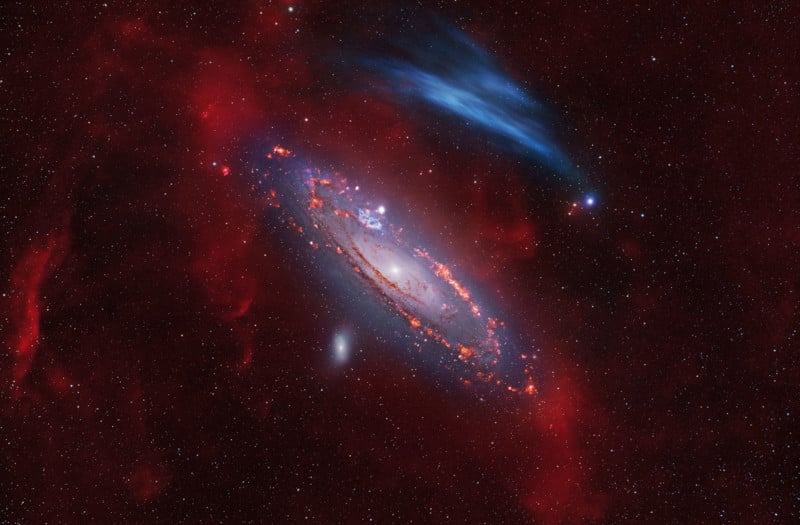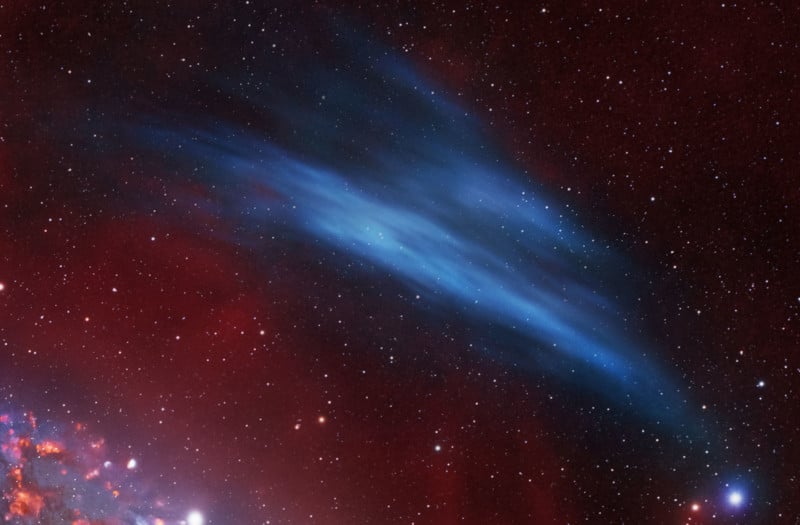Astrophotographers Discover Huge Oxygen Nebula Near Andromeda Galaxy

An astrophotographer helped discover an oxygen nebula located next to the Andromeda Galaxy, the nearest galaxy to the Milky Way.
The Andromeda Galaxy is 2.5 million light-years from Earth, a short distance relative to the vastness of space, and it is one of the most photographed celestial objects ever which raises questions as to how the gigantic blue nebula was missed for so long.
How has the Andromeda Oxygen Arc only just been Discovered?
Astrophotographer Bray Falls was contacted by fellow space documentarians Yann Sainty, Marcel Dreschsler, and Xavier Strottner after Sainty noticed “weird things” going on while imaging the Andromeda Galaxy with an Oxygen-III filter.
“They determined there was something interesting going on that needed a secondary follow-up to help rule out potential sources of error for the strange data,” Falls tells PetaPixel.
“Things like gradients, lens flares, or bad flat frames could create artifacts that confuse us astrophotographers into thinking we see something real.”

The ghostly images showing up on astrophotographers’ cameras were not aberrations but an oxygen nebula very close to the extensively studied Andromeda Galaxy.
“The night sky is full of different types of gases and dust that we as astrophotographers can choose to look at,” Falls explains in his YouTube video below.
“We can use special filters called narrowband filters to look at light from specific gases only.”
Hydrogen is the dominant gas in the universe, most astrophotographers use an H-alpha filter. The other two narrowband filters are Oxygen III (O-III) and Sulfur II.
“The hints that there was a possibility of something new came through in the O-III filter,” says Falls.
The O-III filter is often overlooked because it is subject to light pollution and can be incredibly faint in the night sky.
“For his reason, not a lot of astrophotographers collect lots of data or images in this filter making it hard to see what lies out there in space,” explains Falls.
“But, if you have the patience and are willing to put down a lot of exposure time there are a lot of hidden things in oxygen and oftentimes completely undiscovered objects which is the case for this nebula around Andromeda.”
How they Captured the Oxygen Nebula Arc
Falls and Sainty both pointed their telescopes at the same spot in the sky and collectively captured 110 hours of data, taking countless images at 5 to 10-minute exposure times, in an attempt to resolve the details of the pale oxygen nebula.
“Our initial images of this oxygen arc were very, very noisy because this arc is incredibly faint,” says Falls.
![]()
How Falls and Sainty resolved the images in such stunning detail is incredibly complex, involving extracting the unwanted blue colors that are also captured by the oxygen filter in a process known as continuum subtraction.
However, after the pair put in the work they were able to see the oxygen nebula in all of its glory.
“Both of us were able to verify that this is a real thing that’s really around the Galaxy,” adds Falls.
Falls used a Takahashi FSQ-106 telescope with a .73 reducer and a QHY600 CMOS sensor at the Sierra remote observatory.
“With this combination at f/3.6 and a short focal length of about 400mm, I was able to get a wide field-of-view with very fast speeds allowing me to get a great amount of details on the nebula.”
Mindboggling Discovery
Despite Falls and Sainty’s stellar work imaging the oxygen nebula, scientists are unsure as to what exactly it is.
“It’s an active area of study and we don’t really know yet,” says Falls. “It’s been a topic that’s been being studied for the last four or five months… This is what happens when you’re dealing with new discoveries.”
Falls is thrilled to have been involved with capturing the oxygen arc which has been named after the trio that first discovered it; Strottner Drechsler Sainty 1 (StDrSa-1). Falls says he’s surprised that nobody else had spotted it previously.
“It is faint, but it’s not that faint,” he says. “You can detect it within the course of maybe 10 to 15 hours, thousands of people have observed this part of the sky over the last couple hundred years and it’s mindboggling that someone hasn’t noticed this until now.”
Falls describes the process as “like going fishing for months without getting any bites.”
“But once you do get a bite it is quite special, the significance of the moment is that you are the first person in history who gets to see something for the first time,” he says.
“I imagine it’s similar to being the first person to discover a huge cave or see the grand canyon, but the discovery instead happens behind a computer after hours of processing.”
More of Falls’s work can be seen on his website, Twitter, Instagram, and YouTube.
Image credits:Images courtesy of Bray Falls.